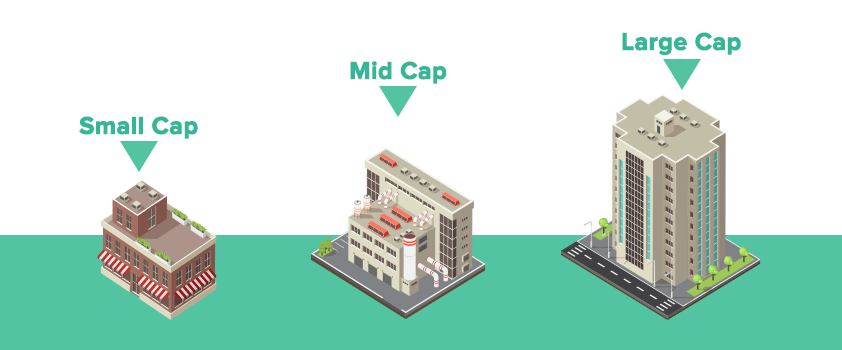If you want to generate profitable returns in the future, there is no better way than saving money and investing in mutual funds. Many mutual funds are present in the market based on risk appetite and market capitalisation. As an investor, you may have heard of different terms, including small-cap, mid-cap, large-cap, and even blue-chip funds. There is a significant difference in all these funds; hence, understanding them before purchasing is a good option. Let’s know them in this article.
What is Market Capitalisation
Market capitalisation is the value of the company traded on the stock market. It is computed by taking the current market price per share and multiplying it by the total number of shares. For market capitalisation, use the following formula:
Market cap = total number of outstanding company shares * current market price of share
Let’s understand it through an example. If the current share price is INR 10 of a company and the outstanding shares are 100,000, the market cap will be:
100,000*10 = 10,00,000
Based on these market caps, the companies are registered as small, mid, or large. Here are the guidelines followed by SEBI:
- Small cap – companies ranked below 250 in market capitalisation
- Mid-cap – companies ranked between 101 and 250 in market capitalisation
- Large-cap – companies ranked between 1 and 100 in market capitalisation
Also, remember that the market cap fluctuates because of the share price. If the company increases its shares to the public, the market cap also increases. Similarly, the market cap decreases when the companies buy back their shares.
What are Large Cap Funds?
The funds with a market capitalisation of over INR 20,000 crores are termed large cap. These funds are invested in well-established companies, such as Reliance, ITC, and SBI, with a proven success track record. These companies are often the leaders in their respective segments and industries.
What are Mid Cap Funds?
A mid-cap fund invests in mid-cap firms with solid growth potential that don’t carry the same risk as small caps because they’ve already reached a specific size and stability. An excellent example of a mid-cap fund is the Quant mid cap fund, which shows good returns.
What are Small Cap Funds?
Investing in small-cap companies that are now experiencing significant potential growth but are also hazardous is what a small-cap fund does. Small-cap stocks may be significantly more volatile than large-cap equities, which are generally more steady. Some examples of these funds are Shobha Ltd, Bajaj Consumer Care, and VST industries.
What Sets Large Cap, Mid Cap, and Small Cap Apart
| Aspect | Large Cap | Mid Cap | Small Cap |
| Company type and stature | Stable and well-established | Compact with growth potential | Smaller with significant growth |
| Liquidity | High | Lower | Least |
| Market capitalisation | INR 20,000 crores and more | Between INR 5,000 and 20,000 crores | Less than INR 5,000 crores |
| Growth potential | Lower | Moderate | Higher |
| Volatility | Low | Moderate | High |
Large Cap vs Small Cap vs Mid Cap – Which is Best for You?
Adding a combination of all three funds to your portfolio is the most excellent method to diversify it. For example, you can allocate 50–70% of your assets to large-cap funds and the remaining to small- and mid-cap funds (such as Quant mid cap fund). Several criteria may influence your decision, including your investing purpose, time horizon, and risk tolerance.
Over time, small-cap and mid-cap funds—like Quant mid-cap fund—may provide higher returns and profits. There is a significant danger involved, though. Small caps are appropriate for investors with a longer investment horizon—say, ten years—and a more substantial risk tolerance. Conversely, investors seeking a five to seven-year investing choice want to choose a blend of large and mid-cap funds.
Conclusion
Understanding the distinctions between large, mid, and small-size mutual funds is essential when examining the world of finance. There are advantages and disadvantages to each group. Therefore, you need to think about and assess your risk tolerance, financial objectives, and investment horizons before making the final decision. It will be preferable to select and invest in the appropriate mutual fund after you thoroughly understand it. But keep in mind that none of them can guarantee a return because that relies on the state of the market.
References
- https://groww.in/blog/large-cap-mid-cap-small-cap-do-you-know-the-difference#:~:text=Mid%2Dcap%20funds%20have%20moderate%20volatility%20and%20moderate%20liquidity.&text=Small%2Dcaps%20stocks%20are%20more%20volatile%20and%20have%20less%20liquidity.&text=Large%2Dcap%20offers%20a%20steady,and%20they%20have%20less%20volatility.
- https://www.shareindia.com/knowledge-center/mutual-fund/understanding-small-cap-mid-cap-and-large-cap-funds#:~:text=Large%20cap%20funds%20offer%20stability,investment%20goals%2C%20and%20time%20horizon.
- https://www.livemint.com/money/personal-finance/mutual-funds-large-cap-vs-mid-cap-vs-small-cap-how-to-find-the-best-mfs-for-you-11684997615690.html
